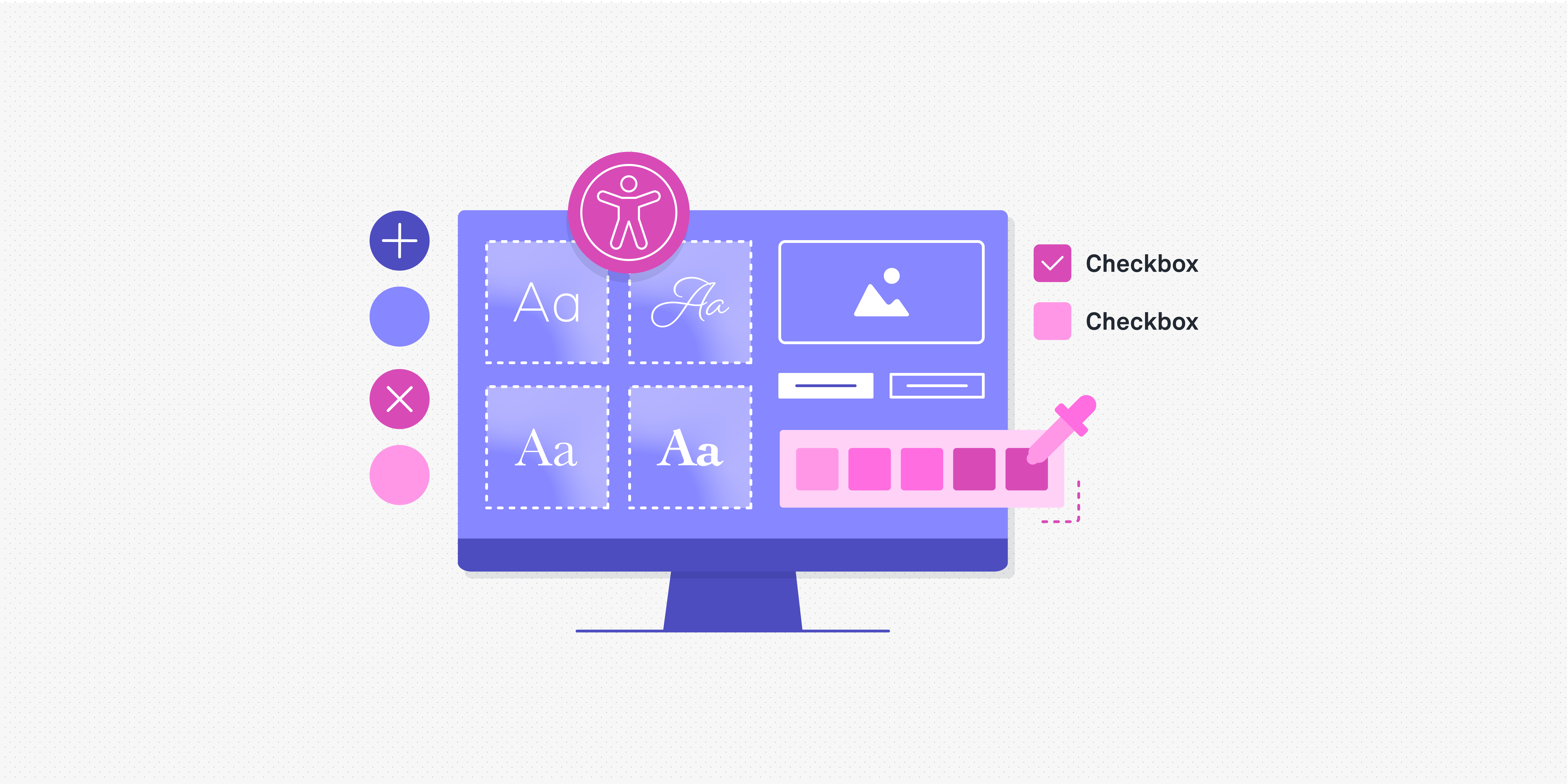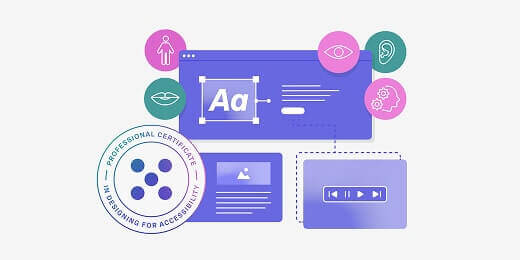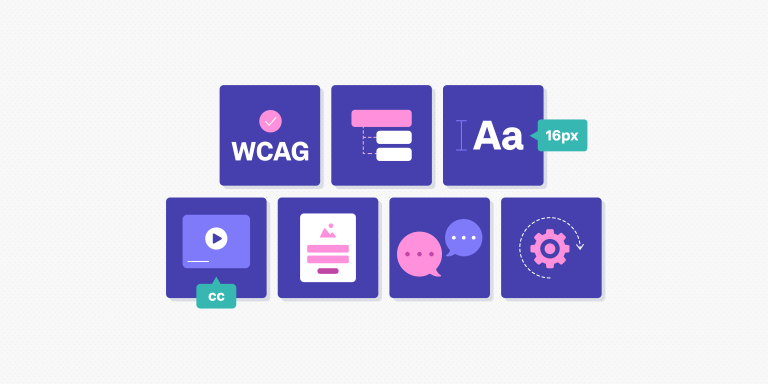What is an accessible design system?
A design system is a collection of reusable components, guidelines, and standards that teams follow to build consistent, cohesive products.
It’s a bit like a recipe book for a restaurant, ensuring every chef uses the same ingredients and follows the same steps to create signature dishes. That way, diners in the restaurant get the same great taste every time, no matter who’s cooking.
Similarly, a design system contains all the building blocks needed to create websites and apps: things like buttons, icons, typography, colour palettes, and interaction patterns.
That’s design systems. So what about accessible design systems?
Now let’s imagine you want to bake a high-protein cake. You could follow a standard cake recipe and then try to add the protein afterwards…or you could follow a recipe that already includes protein-rich ingredients.
The second approach is much more reliable and straightforward (and it’ll save you time).
The same goes for accessibility. It’s much more effective to bake accessibility into your designs from the very beginning than it is to try and bolt it on later.
And that’s exactly what an accessible design system does. It’s just a normal design system, but with accessibility practices baked in. Every component is designed to be accessible by default, and that ultimately results in more consistently accessible products.
Rather than ‘cooking from scratch’ every time, you’re referring back to your trusted recipe and stock of ingredients, ones that you know are inherently accessible and inclusive.
Read also: What is a design system and why is it useful?
|
Why accessible design systems matter
Accessible design systems matter because accessibility matters.
The World Health Organization estimates that 1 in 6 people worldwide live with a disability. Yet, in their analysis of the top 1 million website homepages, WebAIM found that over 94% had accessibility issues.
The digital realm is nowhere near where it needs to be in terms of providing inclusive, user-friendly experiences to all and designers have a critical role to play in changing that.
Designers and product teams must prioritise accessibility in order to:
- Create products, services, and experiences that everybody can use and enjoy
- Ensure compliance with ever-tightening legal requirements (like the European Accessibility Act)
- Meet consumer expectations and keep up with competitors who are already leading the way with accessible and inclusive design
We need accessible design to close the accessibility gap, but it can’t just be an afterthought or an add-on.
It needs to be woven into the very fabric of the product, right down to every last detail. It needs to be a collective effort shared across product teams, and it needs to be consistent and ongoing.
That’s why accessible design systems are so important. They ensure that accessibility is a fundamental part of both the product design process and the product itself.
When you build an accessible design system, you’re embedding accessibility best practices into every component and guideline that shapes your product. This helps to create products that are consistently inclusive across every screen, page, or feature.
From there, accessibility becomes scalable. No matter how big or complex the product grows, accessibility standards remain intact because they’re embedded into the product’s core ‘recipe.’
With an accessible design system, you don’t need to waste time fixing accessibility issues later on or making costly revisions, and you don’t need to scramble to meet new accessibility laws and requirements. You’re prioritising accessibility from the start and committing to it long-term.
Accessible design systems are an incredibly powerful tool, and they’re a fundamental step towards more accessible design. So how do you build one?
We’ll share our step-by-step guide shortly. But first, let’s break down the key components you’ll find in every accessible design system.
The key components of an accessible design system
To create an accessible design system, you’ll need the following building blocks:
Inclusive UI components
These are the interactive elements you use every day, like buttons, forms, navigation menus, and modals.
In an accessible design system, these components are designed to be accessible right out of the box. That means they have clear focus indicators, support keyboard navigation, and include ARIA roles and attributes so they can be easily interpreted by screen readers.
Semantic structure and coding guidelines
Your design system should provide clear HTML and CSS guidelines that make sure everything is built with meaningful, semantic structure.
This helps assistive technologies interpret your content correctly. Good documentation also makes it easier for your team to keep accessibility consistent across the board.
Colour, contrast, and typography
An accessible design system uses colour palettes with sufficient contrast, scalable typography, and thoughtful spacing to ensure content is legible for users with varying visual abilities.
Patterns and usability standards
In an accessible design system, reusable templates and interaction patterns are designed with accessibility in mind. This includes built-in support for keyboard navigation, screen readers, and other assistive technologies.
Accessibility testing and maintenance
Ongoing testing (both automated and with real users) is key to maintaining accessibility over time. A good design system includes guidelines and tools for validating accessibility and updating components as standards and user needs evolve.
Those are the building blocks. Now how do you bring them all together into a cohesive and repeatable design system? Let’s take a look.
How to build an accessible design system (step-by-step)
Whether you’re revising an existing design system or building one from scratch, here’s how to prioritise and improve accessibility throughout.
1. Define accessibility standards from the start
Before you do anything else, set a clear benchmark for how you’re defining and measuring accessibility. For example, you might build your design system to meet WCAG 2.2. Level AA requirements (that’s what most products should be aiming for).
At this stage, make sure you also consider legal requirements in your region. If you’re in the European Union (or serving customers in the EU), for example, you’ll need to comply with standards set out by the European Accessibility Act.
Whatever standard you’re aiming for, document it. This gives everyone a shared target and will help you build your design system accordingly.
Read also: What are the Web Content Accessibility Guidelines (WCAG) and why are they so important?
2. Audit your existing design system (or choose a proven framework to create a new one)
If you already have a design system in place, now’s the time to review it. Look at your existing components and check how they perform when it comes to accessibility.
Are they keyboard accessible? Do they use semantic HTML? Is colour contrast sufficient? How do they behave with screen readers?
Here are some tools and techniques to help you with the audit:
- Automated checkers like Axe DevTools, Lighthouse, or WAVE can quickly flag common accessibility issues.
- Keyboard testing: Try navigating your components using only the keyboard (Tab, Enter, and arrow keys). Can you access all interactive elements? Is the focus order logical and visible?
- Screen reader testing: Use a screen reader like VoiceOver (Mac), NVDA (Windows), or TalkBack (Android) to check whether your components are announced properly and make sense when read aloud.
- Colour contrast checkers like Contrast Grid or WebAIM’s Contrast Checker help ensure your text is readable against background colours.
- Semantic HTML review: Inspect your code to make sure you’re using semantic elements (like <button> instead of <div>) and appropriate ARIA attributes where necessary.
Once you’ve identified where things fall short, map out a plan to improve accessibility across your components.
If you’re starting your design system from scratch, don’t reinvent the wheel. Use a trusted system like the GOV.UK design system or Google’s Material Design as a foundation. These frameworks already include accessible components and patterns you can learn from and adapt.
3. Build accessible components (or refactor existing ones)
As we outlined earlier, every accessible design system is made up of accessible components. So the next step is to either create your accessible components from scratch, or refactor existing components to make them more accessible.
Focus first on the elements users interact with most, especially those that often cause accessibility issues: buttons, links, forms, input fields, modals, navigation menus, and tabs.
As you go, keep these best practices in mind:
- Use semantic HTML wherever you can
- Include clear labels (both visible labels and ‘hidden’ labels for screen readers)
- Make sure every component works with a keyboard
- Test with assistive tech, not just visually
Your components form the foundation of your design system, so take the time to get them right and make sure they’re accessible by default.
4. Create clear and accessible documentation
A good design system doesn’t only show how components should look and function. It also explains how to use them properly.
Create clear documentation that guides people on how to build accessible experiences using the system and components you’ve created. Include:
- A clear explanation of each component’s accessibility features
- Examples of both correct and incorrect usage
- Live demos or code samples that show accessibility in action
- General guidelines and best practices for accessibility
- An accessibility checklist (we’ve written an essential accessibility checklist for designers here, you can use it to guide you)
And remember: your documentation must be accessible, too. Use plain language, easily readable formatting, clear examples and content that makes sense for everyone, not just designers and developers.
Store your documentation in a shared space that everyone can access, and remember to update it regularly as your design system (and product) evolves.
Read also: The best UX documentation tools (and why you need them).
5. Establish processes for regular testing and maintenance
Accessibility isn’t a one-time effort; it needs to be continuous and ongoing. Make sure you’re regularly testing your components and keeping your design system up to date as standards evolve and your product changes.
Build accessibility checks into your team’s workflows so they become part of the day-to-day process, not a separate task at the end. For example, you can:
- Use automated tools like Axe, Lighthouse, or WAVE during development
- Test components manually using a keyboard and screen reader
- Run accessibility audits during major updates or new releases
- Encourage feedback from users with disabilities
- Assign accessibility champions to help embed best practices across teams
Keeping your design system accessible over time isn’t just about fixing issues. It’s also about building a culture of inclusion into how you design, build, and ship every day.
Bonus tip:
Make building an accessible design system a collaborative effort across teams. Involve designers, developers, content designers, and accessibility specialists. This helps to create a shared understanding and sense of accountability around accessibility, which is crucial for ensuring your design system has maximum impact across the organisation.
Avoid these common pitfalls when building your accessible design system
Even with the best intentions, there are some common mistakes that can limit the impact of your accessible design system. Here are some pitfalls to look out for, and how to avoid them:
Pitfall #1: Treating accessibility as an add-on
You already know that accessibility needs to be embedded in the design process from the very start, and that’s why you’re building an accessible design system.
However, there’s always the danger that people only refer to the system at the end of a project, using it as a checklist rather than a foundation or starting point.
To avoid this, make sure your design system is positioned as a core, go-to resource that’s part of everyday workflows, not something you only consult when the work is done.
Pitfall #2: Focusing only on visual design
It’s easy to assume that if something looks clean and clear, it must be accessible. But accessibility goes beyond how things look. Make sure your team is also testing how components behave, using a keyboard, navigating with a screen reader, and interacting with different states. A visually polished design isn’t enough if users can’t actually use it.
Pitfall #3: A lack of knowledge and training around accessibility
An accessible design system is a great first step towards more accessible design. But if your team doesn’t have the knowledge, skills, mindset, and confidence to prioritise and advocate for accessibility, it will only get you so far.
To truly make an impact, pair your design system with ongoing skills development, be that through in-house workshops, peer-to-peer learning, or formal training.
If you’re serious about leveling up your approach to accessibility, check out the UX Design Institute’s Professional Certificate in Designing for Accessibility.
Through self-paced modules, an expert-led curriculum, and practical exercises, you’ll learn how to embed accessibility into your design process, from research and testing, right through to championing accessibility and getting stakeholder buy-in.
|
The takeaway
Accessible design is about creating products and services that everybody can use. Ethically, it’s the right thing to and from a business perspective, it’s crucial for staying compliant and competitive.
With an accessible design system, you can embed accessibility right into your design process and make sure it’s a priority for everyone working on the product. Follow the steps we’ve laid out in this guide to improve your existing design system or build a new one from scratch.
And remember: accessibility is an ongoing effort, not a one-off checkbox. Keep learning and adapting your design practice as accessibility standards evolve.
Want to learn more about accessible design? Check out:
- Making accessibility real: practical insights from Skyscanner’s Head of Accessibility, Heather Hepburn
- How to optimise your website for user experience accessibility






